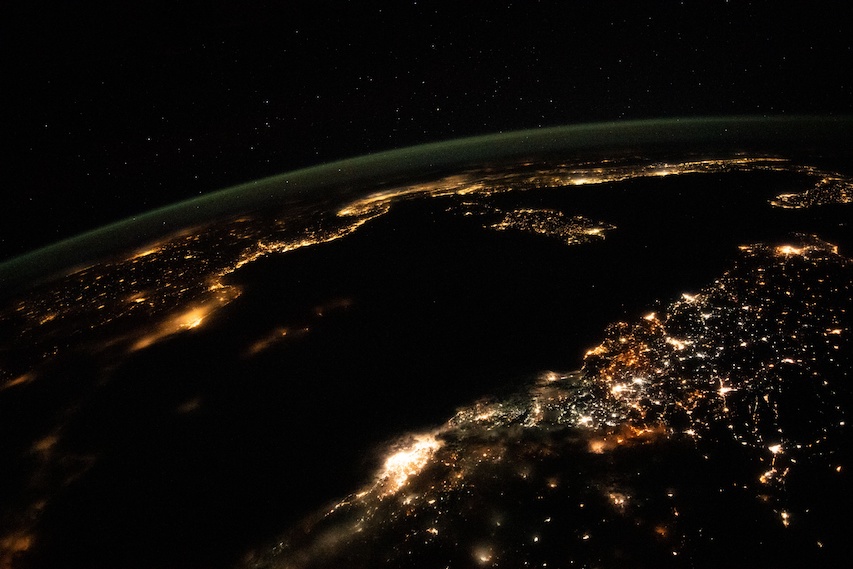Latest News

Photo: NASA image of Earth taken from the International Space Station
2023 was a very eventful year in the satellite industry, and a number of companies made significant announcements as the industry heads into this unprecedented multi-orbit era. 2024 promises to be as equally as significant as companies look to make good on bold, ambitious business plans with more competition than ever.
To kick off the new year, Via Satellite reached out to a number of the industry’s most well-known names to find out how they viewed the events of 2023. This roundtable features Nobu Okada, CEO of Astroscale; Michelle Parker, vice president of Boeing Space Mission Systems; Rui Pinto, CEO of SES,and David Wajsgras, CEO of Intelsat.
VIA SATELLITE: There were a number of completed deals in 2023 with Eutelsat/OneWeb, Viasat/Inmarsat, interesting announcements from the likes of Telesat and Amazon, lots going on with SpaceX/Starlink, and the drama around Viasat-3. If you had to pick two major events in 2023 for the industry, what events would you pick and why?

Nobu Okada. Photo: Astroscale
Okada: The major satellite company deals were certainly big events for the industry this year and the outcomes of these mergers will shape the sector for years to come. These combinations of GEO and LEO operators working together highlight the continued growth of the sector overall. Global attention is continuing to shift toward sustainability in space with the major commitments of the year from the G7 Hiroshima Leaders’ Communique, the FCC adopting a new 5-year rule for deorbiting satellites, and ESA’s Zero Debris Charter.
Parker: 2023 was a monumental year for the satellite industry. From our perspective at Boeing, the Victus Nox mission stands out, showcasing our commitment to tactically responsive space. We set new operational records across the board, delivering, launching, and deploying capability on orbit in record speeds. Where do we go from here? Our ultimate goal is to get to an enduring capability for the DoD. Between now and then, we will take lessons learned from Victus Nox and roll those into other programs.
Additionally, the delivery and launch of the fifth and sixth O3b mPOWER satellites marks a significant milestone. This expansion enables SES to provide global coverage from Medium-Earth Orbit with just six satellites, paving the way for more sustainable, high-speed connectivity globally. We see this technology charting a path forward for both commercial and government customers.
Wajsgras: I’d start with the continued consolidation, as two big mergers were completed in 2023: Viasat/Inmarsat and Eutelsat/OneWeb. These mergers have been talked about for a number of years, and it’s not surprising that they were completed in 2023. Since I joined Intelsat, I’ve been saying that consolidation will benefit the industry. In general, these transformative transactions drive competition and fuel innovation, which are essential in a rapidly changing industry. Second, I’d point to the fact that the industry saw a record amount of new satellite capacity entering service in 2023, across all orbits. Intelsat alone put a record eight GEO satellites into orbit in the span of 10 months, concluding in August. All of these new satellites will deliver new capabilities, satellite architectures, applications and technologies that are aimed at helping customers grow and address their challenges.
VIA SATELLITE: Where do you think the satellite industry will be by the end of the decade?
Okada: Space development is not going to slow down, and we can expect to see more progress on constellation build-outs. We are at a fork in the road and industry could go down one of two paths – one where we are at overcapacity in LEO and the orbits remain congested, contested, and competitive; or a path of global coordination and active efforts to maintain a sustainable orbital environment.

Michelle Parker. Photo: Boeing
Parker: Looking ahead, we envision an interconnected future with multi-orbit, multi-mission satellites. These advanced systems will work collaboratively to enhance global connectivity. Technologies like software-driven payloads, such as Boeing’s 702X, will be the standard; there will be increased interconnectivity between systems via optical crosslinks; and on-board AI/ML-enabled data processing will start to see broader use.
There will also be increasing collaboration and interconnectivity among commercial and government satellites, enabled by systems such as Protected Tactical Enterprise Services (PTES). Nations that have stood up their own Space Forces, and are seeking a sovereign space capability, will begin to operate their own satcom assets. We see a resilient, growing marketplace that will invite innovation and investment.
Wajsgras: We are going to be adapting to the evolving landscape of needs from customers. Merely providing bandwidth will be just a sliver – maybe 10% to 20% – of the total addressable market for satellite communications companies in 6 or 7 years. Being a fully-integrated solutions provider partnering with our customers to achieve their outcomes – well, we think that’s where the action will be. That’s the direction Intelsat is headed over the next few years, and our strategy supports this.
Also, the industry will be more ‘multi-orbit’ going forward. By the end of the decade, we will see more terminals operating in a multi-orbit domain. Intelsat already has a dual-orbit terminal operating from a ground perspective being used primarily by the military. But by the end of 2024, we will be using similar terminals that operate in the air, specifically for commercial aviation. Our multi-orbit antenna and services have already been selected by some of the world’s largest airlines, including American Airlines, Air Canada, Alaska Air and others. Air passengers will have more reliable, higher quality connectivity than they’ve had in the past. That’s resonating across commercial and business aviation.
VIA SATELLITE: Do you think a multi-orbit strategy is a must for big, legacy operators to be successful?
Okada: I don’t think it’s a must as it will depend on the mission line e.g., if you’re a communications operator and want to mix low latency LEO with traditional stable GEO, then yes, it is getting to that point. For the on-orbit servicing sector, it is also getting to that point where you need a multi-orbit strategy and develop services in LEO and GEO to expand business cases.
Parker: Adopting a multi-orbit strategy is indeed crucial for many operators, especially legacy ones seeking to grow or maintain their place in the market. This approach ensures versatility and adaptability, essential in today’s fast-evolving satellite landscape. We’re seeing that many smaller regional operators have announced partnerships in MEO or LEO. Still, there are operators with focused business cases that can remain successful in GEO – particularly in regions where customers are highly price sensitive.

Ruy Pinto, SES
Pinto: Considering SES is the first operator to operate in two orbits, the short answer is yes. We are fortunate that we live in the golden age of satellite innovation. Investment in space has never been this high and businesses and consumers are spoilt for choices. As one of the leading satellite players in the industry, I would argue that if we want to be truly successful, we should really listen to what our customers want and offer the right technology to address our customers’ needs. Satellites operating in GEO, MEO or LEO orbits have their strengths and weakness, and it’s on us to offer the most cost and spectrum effective network for our customers’ dynamic needs and ensure we jointly deliver amazing experiences to everyone.
Wajsgras: In many cases, multi-orbit is an absolute must. It’s not a convenient talking point; it’s reality. If companies in our industry are going to be successful in becoming fully-integrated solutions providers, as I described a moment ago, there’s no way any single-orbit solution can adequately enable that.
We’re already working with LEO providers in several domains. For example, we partner with OneWeb to offer those multi-orbit solutions I mentioned for commercial aviation and MNO customers. We are also working with LEO providers to offer multi-orbit capabilities for governments – primarily in the U.S., but we’re seeing a lot of interest also from our closest allies across the world.
VIA SATELLITE: Will AI be a good or bad thing for the space industry? Will it have less or more impact in space compared to other industries?
Okada: AI will have a huge impact on the space industry, and I think it’s a good thing. For example, the integration of AI, machine learning, robotics, and 3D printing, will revolutionize on-orbit servicing. Automated systems could handle complex servicing tasks such as diagnostics, repairs, or even upgrades of satellites autonomously. This would increase the efficiency and reliability of servicing missions while reducing the risks associated with human spacewalks. One of the main trends we see coming for the satellite sector over the next decades is a large increase in the number of satellites in orbit and as a result an exponentially growing need for space situational awareness. It may also be that AI helps us to model this orbital environment and provides another tool in support of space traffic management. On the other hand, it is possible that advances in AI will facilitate the control and management of ever-larger satellite constellations.
Parker: AI stands to be a transformative force in space. The space industry generates a lot of data – communications, imagery, weather – and innovations that can more efficiently garner intelligence and conclusions out of this data will be critical. Its impact on space exploration and satellite technology could be more profound compared to other industries, given the unique challenges and opportunities in space. We are incorporating AI capabilities in our satellites to enable new revenue opportunities for our customers and ensure resilience. We will continue evolving and incorporating technology, certainly.

David Wajsgras, Intelsat
Wajsgras: Digital transformation is here to stay, and we are still in the early stages. Changes driven by advancement in software technologies like AI will continue to disrupt every industry, including ours. I think it’s a good thing, and Intelsat is embracing it.
To achieve true virtualization and digitization in this industry, a delicate dance must be orchestrated among all components of the network, including intelligent terminals and modems, network hubs located at ground stations around the world, and the satellites themselves. The more these components can seamlessly interact with each other without the intervention of humans, the closer we get to a true virtualized satellite communications network.
With this knowledge as the driver, our team is developing a highly sophisticated Resource Management System (or RMS) that will absolutely minimize the manual management of satellite network traffic, optimize bandwidth delivery based on changing conditions and evolving demands, and automatically orchestrate the entirety of traffic flow across the network. Now, how our industry ranks in terms of more or less impact compared to other sectors, I’m not sure. But I will say the impact for space – the positive impact – will be considerable.
VIA SATELLITE: What do you think will be the three main talking points at SATELLITE 2024?
Okada: Next-generation reusable launch vehicles. Advanced space manufacturing utilizing robotics, 3D printing, and other innovations. Space sustainability will continue to be a main topic, from on-orbit servicing to space traffic management, and space situational awareness.
Parker: If I were to prognosticate, the 2024 conference will likely focus on growing investment in space – particularly among developing and allied governments, the continued proliferation of satellites in LEO, and the merging paths of government and commercial space missions.
Wajsgras: Number one is how satellite companies are going to address the convergence of a changing world – with new technologies, threats and opportunities. Into this big bucket of “change,” I would throw the growth in the IoT ecosystem, cloud connectivity, 5G-enabled applications, AI and machine learning. I’d also point to the global threat environment, as well as natural and manmade disasters. Add to this the challenges of connecting 3.5 billion unconnected people, all at a time in which sustainability will continue to grow in importance. So, short answer for this talking point is: the value proposition brought by satellite companies to address big problems and critical needs.
Second (because as technology companies, we can’t help ourselves), a big talking point will be about the technology and innovation that our industry is working on: Software-defined, 5G, non-terrestrial and terrestrial networks, new smart terminals, in-orbit servicing, multi-orbit platforms, optical data transfer, etc.
VIA SATELLITE: Do you believe the satellite industry has seen a fundamental shift over the last few years? How would you classify the pace of change?
Okada: The satellite industry has undergone a significant transformation in recent years with a surge in satellite launches, driven by mega constellations, and an increase in space players, from both companies to countries. This growth has led to a concerning deterioration in the space environment, resulting in rising risks and diminishing returns for operators. While governments and international groups are starting to acknowledge these risks, the regulatory framework has not kept up to pace with the rapid growth.
Parker: The pace of change in the satellite industry has been rapid and is set to continue. We’re witnessing a fundamental shift, with advancements in technology (software driven payloads, commercialization of optical crosslink terminals) and strategic collaborations reshaping the industry’s landscape.
Pinto: Years ago, Canadian Prime Minister Justin Trudeau said the pace of change has never been this fast, yet it will never be this slow again. He was referring to technology in general, and I fully agree that this is what we are seeing in the satellite industry which has traditionally been slower in embracing change.
Compared to the last few decades, the last few years has seen more disruptive changes. As we see the space and ground segment industries go down the path of virtualized, software-defined and artificial intelligence systems, we are thrilled because it is enabling us to agile and flexible in meeting our customers’ dynamic needs. This essentially means our next-generation satellites no longer have to be built to last for 15 years, and our next-generation ground networks can be rerouted with the push of a button. The pace of change is needed, and required for us to complement all other networks to satisfy demands of today’s consumers.
Wajsgras: There has absolutely been a fundamental shift. Space is once again the “new frontier,” as people are discovering ways for satellites to help solve problems here on the ground. In just a handful of years, many industry players have moved from being primarily bandwidth providers to being solutions partners. That’s impressive for an industry and a model that’s been around for decades.
In addition, we’ve seen a shift as a result of digital transformation, and we are still in the early innings on that. Intelsat “turns 60” in 2024, and – while we are extremely proud of our history and heritage as the pioneering satcom company – everyone on the team is laser-focused on leading the way into the future for this industry.
Stay connected and get ahead with the leading source of industry intel!
Subscribe Now